|
||
| In
2006, twenty-five artists marked the 100th anniversary of Amundsen’s
1906 navigation through the Northwest passage with a journey of their
own. |
Artist's
statements on the Arctic |
| Artists are the great observers
of our world, and for centuries recorded images for future generations
to view. Please read what each has to say. Click on image to read their biography. |
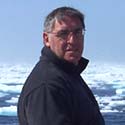 Robert
Amirault My trip to Canada's high Arctic was multifaceted...like
looking through a finely cut gem and seeing the world's skeleton. The
incredible reserved beauty of the landscape, spectacular colour in the
sea, sky and ice formations, breathtaking animals existing the best they
can in a changing climate, and native Canadians challenged by the environment
and their living conditions, but surviving nonetheless. Robert
Amirault My trip to Canada's high Arctic was multifaceted...like
looking through a finely cut gem and seeing the world's skeleton. The
incredible reserved beauty of the landscape, spectacular colour in the
sea, sky and ice formations, breathtaking animals existing the best they
can in a changing climate, and native Canadians challenged by the environment
and their living conditions, but surviving nonetheless. |
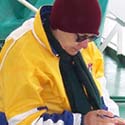 Kim
Atkins Thoughts on climate change in the Arctic:
I spoke at length to a visitor to our show in Toronto last month. A woman
who had been to the Arctic about 14 years ago and had returned recently.
She told me how shocked she had been to see the growth in vegetation.
Places which had been rock covered and bare were covered with green and
tiny plants were similar in size to plants we see in southern Canada. Kim
Atkins Thoughts on climate change in the Arctic:
I spoke at length to a visitor to our show in Toronto last month. A woman
who had been to the Arctic about 14 years ago and had returned recently.
She told me how shocked she had been to see the growth in vegetation.
Places which had been rock covered and bare were covered with green and
tiny plants were similar in size to plants we see in southern Canada. |
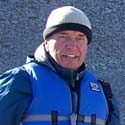 Anthony
J. Batten Thoughts on climate change in the Arctic:
This was my first visit to the Arctic and I was enthralled by its unanticipated
overblown scale. Everything was enormous - the bird population, the long
windswept beaches, the glaciers and above all the towering cliffs. This
painting shows a melt-fall cascading into the sea at Cape Hay. With its
dynamic seasonal transformation and erosion, it encapsulates the sense
of change that permeates the Arctic experience. Anthony
J. Batten Thoughts on climate change in the Arctic:
This was my first visit to the Arctic and I was enthralled by its unanticipated
overblown scale. Everything was enormous - the bird population, the long
windswept beaches, the glaciers and above all the towering cliffs. This
painting shows a melt-fall cascading into the sea at Cape Hay. With its
dynamic seasonal transformation and erosion, it encapsulates the sense
of change that permeates the Arctic experience. |
 Heidi
Burkhardt Thoughts on climate change in the Arctic:
The bears we watched on Monumental Island were roaming on barren land
waiting for ice. They need to hunt food, we learned. They don't eat all
summer. Wouldn't it be tragic if the ice never came, and they had to fast
to death... Heidi
Burkhardt Thoughts on climate change in the Arctic:
The bears we watched on Monumental Island were roaming on barren land
waiting for ice. They need to hunt food, we learned. They don't eat all
summer. Wouldn't it be tragic if the ice never came, and they had to fast
to death... |
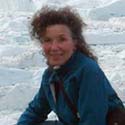 RoseMarie
Condon CCGS Henry Larsen’s bridge a fine
vantage point; I sketched the majesty of the High Arctic July 24 till
late August 1994. Breaking ice in Lancaster Sound escorting ore carriers
and provisioning ships to Nanasivik and Little Cornwallis Island our ice
breaker continuously rode up on heavy first and multi-year pack ice to
open a channel. Cruising Lancaster Sound aboard the Akademik Ioffe in
late July 2006 there was no ice to be found. Enormous glaciers I trekked
on in 1994 near Dundas Harbour were alarmingly diminished. Searching for
pack ice we headed for Greenland looking to encounter animals that forage
and give birth on the ice pack. The sun shone the sea mill pond still,
many of us wore shorts and t-shirts it was surreal. RoseMarie
Condon CCGS Henry Larsen’s bridge a fine
vantage point; I sketched the majesty of the High Arctic July 24 till
late August 1994. Breaking ice in Lancaster Sound escorting ore carriers
and provisioning ships to Nanasivik and Little Cornwallis Island our ice
breaker continuously rode up on heavy first and multi-year pack ice to
open a channel. Cruising Lancaster Sound aboard the Akademik Ioffe in
late July 2006 there was no ice to be found. Enormous glaciers I trekked
on in 1994 near Dundas Harbour were alarmingly diminished. Searching for
pack ice we headed for Greenland looking to encounter animals that forage
and give birth on the ice pack. The sun shone the sea mill pond still,
many of us wore shorts and t-shirts it was surreal. |
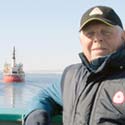 Paul
Gauthier The voyage with Arctic Quest artists
was my seventh excursion into Arctic Territory. Each expedition had its
moments of wonder and visual excitement. Over a period of some 27 years,
I have experienced changing ice patterns and most notably warming trends,
affecting wildlife sustainment and indigenous native population’s
frustrations in harvesting declining species. On my last venture with
Arctic Quest, a scene I observed from the deck of the Akedemik Ioffe vessel
brought this aspect of environmental change to the ecology of the Arctic,
forcefully into view. Here was a lone mature polar bear squatting on a
fragment of ice surrounded by an open sea devoid of pack ice. In order
to survive, the bear needs access to ice, to hunt their seal quarry. We
need to draw attention to environmentalists, government officials and
the general public, that we are indeed experiencing global warming on
a scale that is directly influencing the ecology of this fragile planet.
Future generations will suffer the consequences of our ineptitude in dealing
with what is now a crisis of a monumental continuum of events. Paul
Gauthier The voyage with Arctic Quest artists
was my seventh excursion into Arctic Territory. Each expedition had its
moments of wonder and visual excitement. Over a period of some 27 years,
I have experienced changing ice patterns and most notably warming trends,
affecting wildlife sustainment and indigenous native population’s
frustrations in harvesting declining species. On my last venture with
Arctic Quest, a scene I observed from the deck of the Akedemik Ioffe vessel
brought this aspect of environmental change to the ecology of the Arctic,
forcefully into view. Here was a lone mature polar bear squatting on a
fragment of ice surrounded by an open sea devoid of pack ice. In order
to survive, the bear needs access to ice, to hunt their seal quarry. We
need to draw attention to environmentalists, government officials and
the general public, that we are indeed experiencing global warming on
a scale that is directly influencing the ecology of this fragile planet.
Future generations will suffer the consequences of our ineptitude in dealing
with what is now a crisis of a monumental continuum of events. |
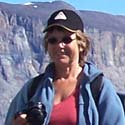 Kathy
Haycock In 1975 I spent a week at Beechey Island,
where the Franklin expedition stayed 1845-46. John Torrington age 20 years
was the first to die. I always have, and always will, think of his memory
when visiting Beechey Island. That was towards the end of “the Little
Ice Age,” when staying over winter meant being iced in 11 months
or 2 or 3 years, or crushed in the ice. This is certainly not the case
now. Perhaps Franklin would have made it through the Northwest Passage
if the climate had been the same then as it is today. Kathy
Haycock In 1975 I spent a week at Beechey Island,
where the Franklin expedition stayed 1845-46. John Torrington age 20 years
was the first to die. I always have, and always will, think of his memory
when visiting Beechey Island. That was towards the end of “the Little
Ice Age,” when staying over winter meant being iced in 11 months
or 2 or 3 years, or crushed in the ice. This is certainly not the case
now. Perhaps Franklin would have made it through the Northwest Passage
if the climate had been the same then as it is today. |
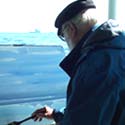 John
Joy I had the opportunity to sit on the deck of
the ship and paint. The ship was in constant motion, but it had little
or no vibration as it was designed for scientific purposes. We had a few
days of constant light and our path took us through various channels and
through constant icebergs and icefields. It has a captivating appearance
that keeps you looking and looking. Sleeping becomes secondary. I managed
4 hours a day - always strange ice forms or long strings of clouds. John
Joy I had the opportunity to sit on the deck of
the ship and paint. The ship was in constant motion, but it had little
or no vibration as it was designed for scientific purposes. We had a few
days of constant light and our path took us through various channels and
through constant icebergs and icefields. It has a captivating appearance
that keeps you looking and looking. Sleeping becomes secondary. I managed
4 hours a day - always strange ice forms or long strings of clouds. |
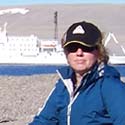 Ana
Jurpik I happened to observe two polar bears during
my voyage to the High Arctic, and know they need ice in order to survive.
Many drown while swimming trying to reach the floes. Will we one day need
to recreate a temperature controlled environment for the bears to be observed,
a super zoo, if they are to continue to exist? Is it not simpler to start
acting as responsible inhabitants of this planet? Ana
Jurpik I happened to observe two polar bears during
my voyage to the High Arctic, and know they need ice in order to survive.
Many drown while swimming trying to reach the floes. Will we one day need
to recreate a temperature controlled environment for the bears to be observed,
a super zoo, if they are to continue to exist? Is it not simpler to start
acting as responsible inhabitants of this planet? |
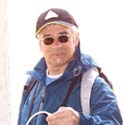 Jack
Koca Thoughts on climate change in the Arctic:
The Arctic trip was an extraordinary experience for me, but I was saddened
to see in person how global warming is affecting the balance in the ecosystem
and the Arctic wildlife. The main observation that I had was how a diminishing
ice pack directly affects polar bears, as sea ice is the platform from
which they hunt seals. Jack
Koca Thoughts on climate change in the Arctic:
The Arctic trip was an extraordinary experience for me, but I was saddened
to see in person how global warming is affecting the balance in the ecosystem
and the Arctic wildlife. The main observation that I had was how a diminishing
ice pack directly affects polar bears, as sea ice is the platform from
which they hunt seals. |
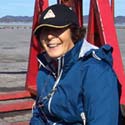 Margaret
Ludwig The World is very Different Now. Climates
are changing, the animals are decreasing in numbers and the earth is shifting.
We must realize now that these are the terrible results of Global Warming.
The melting icebergs and ice floes where the seals, whales and bears live
and feed is fast disappearing. So, if you do not wish to attend the funeral
of the last bear in about seventy years, we MUST act now! Margaret
Ludwig The World is very Different Now. Climates
are changing, the animals are decreasing in numbers and the earth is shifting.
We must realize now that these are the terrible results of Global Warming.
The melting icebergs and ice floes where the seals, whales and bears live
and feed is fast disappearing. So, if you do not wish to attend the funeral
of the last bear in about seventy years, we MUST act now! |
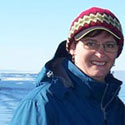 Linda
Mackey Every trip to the Arctic has been a spiritual
and emotional journey for me. Whether it's following an icebreaker and
supply ship through the ice off Devon Island, learning the Inuit survival
techniques and the struggle that they've had throughout history, or seeing
the glaciers melt away and polar bears search for food, as we experienced
this time. The voyage this summer revealed drastic environmental changes
that would even make the mountains cry out to humankind to change our
ways. As the snow is melting on the mountains, the shapes represent tears.
The sunbeams, God's light, reflect on the mountains and snow, giving us
hope that we can change our ways before it's too late. Linda
Mackey Every trip to the Arctic has been a spiritual
and emotional journey for me. Whether it's following an icebreaker and
supply ship through the ice off Devon Island, learning the Inuit survival
techniques and the struggle that they've had throughout history, or seeing
the glaciers melt away and polar bears search for food, as we experienced
this time. The voyage this summer revealed drastic environmental changes
that would even make the mountains cry out to humankind to change our
ways. As the snow is melting on the mountains, the shapes represent tears.
The sunbeams, God's light, reflect on the mountains and snow, giving us
hope that we can change our ways before it's too late. |
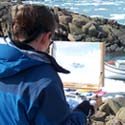 Rhonda
McDonald During my explorations throughout the
Arctic, I have, on occasion, taken for granted many of the impacts that
Global Warming has had on this region. In 2003, I was guilty of scouring
the landscape with only an artistic eye, selfishly starving for the next
scene to grace my canvas. Today, my interpretations of how I translate
the Arctic onto canvas is revealed in my painting titled "On Thin
Ice, Baffin Island". When I first photographed this scene, I was
drawn by the strength and courage of this polar bear having travelled
an incredible distance, hunting for it's favorite meal - the seal - often
found on the sea ice. Reflecting back with heightened scientific awareness
on Global Warming, this polar bear that I first marvelled over has now
become a very poignant scene with emphasizes solely on the bear's survival.
I am hopeful that my painting "On Thin Ice, Baffin Island" will
serve as an educational awareness and leave each viewer with a strong
statement on the effects of Global Warming. Rhonda
McDonald During my explorations throughout the
Arctic, I have, on occasion, taken for granted many of the impacts that
Global Warming has had on this region. In 2003, I was guilty of scouring
the landscape with only an artistic eye, selfishly starving for the next
scene to grace my canvas. Today, my interpretations of how I translate
the Arctic onto canvas is revealed in my painting titled "On Thin
Ice, Baffin Island". When I first photographed this scene, I was
drawn by the strength and courage of this polar bear having travelled
an incredible distance, hunting for it's favorite meal - the seal - often
found on the sea ice. Reflecting back with heightened scientific awareness
on Global Warming, this polar bear that I first marvelled over has now
become a very poignant scene with emphasizes solely on the bear's survival.
I am hopeful that my painting "On Thin Ice, Baffin Island" will
serve as an educational awareness and leave each viewer with a strong
statement on the effects of Global Warming. |
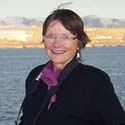 Karole
Pittman Thoughts on climate change in the Arctic:
I've been going to the Arctic since 1968. The summer of 2006 was warm
and unlike any Arctic summer I've ever seen. There was almost no sea ice.
We sought it out, looking for wildlife among the floes. People sat on
deck in bare feet in Lancaster Sound. Baffin Bay was mostly ice-free and
we saw Orcas, unusual this far North. Karole
Pittman Thoughts on climate change in the Arctic:
I've been going to the Arctic since 1968. The summer of 2006 was warm
and unlike any Arctic summer I've ever seen. There was almost no sea ice.
We sought it out, looking for wildlife among the floes. People sat on
deck in bare feet in Lancaster Sound. Baffin Bay was mostly ice-free and
we saw Orcas, unusual this far North. |
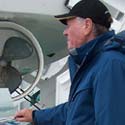 John
Stuart Pryce My initial impression both on the
land and sea was of the pristine vastness of it all. This impression was
soon replaced by the subtle beauty as we were able to look closer. The
painting that I have chosen for your exhibit "Arctic Beacon"
shows the interaction between the Sun's rays and the Iceberg. The beautiful
colours that appear as a prism around the iceberg could also be viewed
as a lighthouse beacon warning us of danger ahead if we do not change
course. John
Stuart Pryce My initial impression both on the
land and sea was of the pristine vastness of it all. This impression was
soon replaced by the subtle beauty as we were able to look closer. The
painting that I have chosen for your exhibit "Arctic Beacon"
shows the interaction between the Sun's rays and the Iceberg. The beautiful
colours that appear as a prism around the iceberg could also be viewed
as a lighthouse beacon warning us of danger ahead if we do not change
course. |
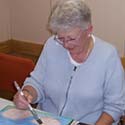 Val
Russell The fjords, glaciers and ice-capped mountains
are now nothing like in times gone by. From the words of the Inuit they
say that due to global warming their lives have been altered immensely
as their livelihood fast disappears. The sightings of polar bears waiting
at the shore-line for the ice to form is now commonplace. In the faces
of the Inuit you can read the harshness of their life on this land that
is melting before their very eyes. I pray that man will have the wisdom
and courage to allow this land to retain its primal beauty and not destroy
what God has created. Val
Russell The fjords, glaciers and ice-capped mountains
are now nothing like in times gone by. From the words of the Inuit they
say that due to global warming their lives have been altered immensely
as their livelihood fast disappears. The sightings of polar bears waiting
at the shore-line for the ice to form is now commonplace. In the faces
of the Inuit you can read the harshness of their life on this land that
is melting before their very eyes. I pray that man will have the wisdom
and courage to allow this land to retain its primal beauty and not destroy
what God has created. |
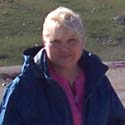 Brigitte
Schreyer Back in the summer of 1989 I visited
the Arctic for the first time. In the 3 weeks I was stationed in Pangnirtung,
Baffin Island, I watched the Pang Fjord slowly open up and melt and I
was having great fun painting the everchanging ice floes. I was not at
all aware of the climate change then. On this Arctic Quest trip to the
High Arctic and Greenland I learned first hand that the ice is dissappearing.
Some of the Locals told me that they are enjoying the longer and warmer
summer, but I know that the polar bears need the ice and they also need
the seals to feed on. I did not see any seals. Brigitte
Schreyer Back in the summer of 1989 I visited
the Arctic for the first time. In the 3 weeks I was stationed in Pangnirtung,
Baffin Island, I watched the Pang Fjord slowly open up and melt and I
was having great fun painting the everchanging ice floes. I was not at
all aware of the climate change then. On this Arctic Quest trip to the
High Arctic and Greenland I learned first hand that the ice is dissappearing.
Some of the Locals told me that they are enjoying the longer and warmer
summer, but I know that the polar bears need the ice and they also need
the seals to feed on. I did not see any seals. |
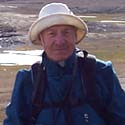 Gerald
Sevier This was my first trip to the High Arctic.
Though we saw numerous icebergs as we approached Greenland I was surprised
and disappointed by the lack of ice and the warm temperatures in Nunavut.
While hiking in Uummannaq, Greenland I dove into a tarn for a refreshing
dip, the day was so unexpectedly warm. The Arctic continues inspiring
me to create paintings of its rugged beauty. Gerald
Sevier This was my first trip to the High Arctic.
Though we saw numerous icebergs as we approached Greenland I was surprised
and disappointed by the lack of ice and the warm temperatures in Nunavut.
While hiking in Uummannaq, Greenland I dove into a tarn for a refreshing
dip, the day was so unexpectedly warm. The Arctic continues inspiring
me to create paintings of its rugged beauty. |
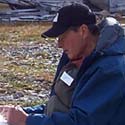 Maurice
Snelgrove We were told that the ice left Resolute
two week's early this year. Some scientists claim that if the current
warming trend continues, it will be irreversible by the years 2015-2020!
I am happy but also discouraged to have had a last glimpse of the Arctic
as we know it. Maurice
Snelgrove We were told that the ice left Resolute
two week's early this year. Some scientists claim that if the current
warming trend continues, it will be irreversible by the years 2015-2020!
I am happy but also discouraged to have had a last glimpse of the Arctic
as we know it. |
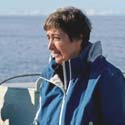 Lynn
Soehner Thoughts on climate changes in the Arctic:
I had a conversation with the curator at the Aasiaat Museum and he said
that Norse history of Greenland was called that for a good reason...it
was green...when Eric the Red explored and named it around 982-985. By
1350 however, the Norsemen had abandoned Greenland to the Inuit with no
explanation other than a mini ice age seemed to have occurred. He was
very accepting of the fact that Greenland was now in a warming cycle. Lynn
Soehner Thoughts on climate changes in the Arctic:
I had a conversation with the curator at the Aasiaat Museum and he said
that Norse history of Greenland was called that for a good reason...it
was green...when Eric the Red explored and named it around 982-985. By
1350 however, the Norsemen had abandoned Greenland to the Inuit with no
explanation other than a mini ice age seemed to have occurred. He was
very accepting of the fact that Greenland was now in a warming cycle. |
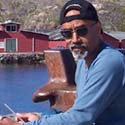 Andrew
Sookrah I would hope that in presenting the art
created as a result of the Arctic Quest 06 trip that we would increase
awareness of the Arctic and encourage people to be more receptive to the
warnings being sounded about the impact of our collective actions on our
environment. Especially the way we are influencing the escalation of global
warming and its impact on that region of the world. Andrew
Sookrah I would hope that in presenting the art
created as a result of the Arctic Quest 06 trip that we would increase
awareness of the Arctic and encourage people to be more receptive to the
warnings being sounded about the impact of our collective actions on our
environment. Especially the way we are influencing the escalation of global
warming and its impact on that region of the world. |
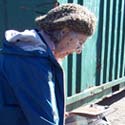 Mary
Wagler The only polar bear I happened to see in
the Arctic was on an isolated ice floe making it a long swim for the bear
to reach the next ice floe. This was information first realized in the
documentary “An Inconvenient Truth”. Mary
Wagler The only polar bear I happened to see in
the Arctic was on an isolated ice floe making it a long swim for the bear
to reach the next ice floe. This was information first realized in the
documentary “An Inconvenient Truth”. |
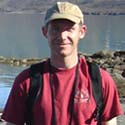 David
Ward Arctic Quest's 2006 journey aboard the Akademic
Ioffe was an experience quite unlike my first trip to the Arctic - a Hiking
trip across Baffin Island in 1993 - both trips however, began in Iqaluit,
the capital of Nunavut. It was apparent, almost immediately, that much
had changed in the North. Iqaluit, which was a city of 3000 the last time
I visited, has now grown to 9000. Only one day earlier back in the early
nineties (July 21st), when I first saw Frobisher Bay, pack ice covered
much of the water just off shore. This year, as satellite maps revealed,
not a piece of ice was to be seen anywhere! David
Ward Arctic Quest's 2006 journey aboard the Akademic
Ioffe was an experience quite unlike my first trip to the Arctic - a Hiking
trip across Baffin Island in 1993 - both trips however, began in Iqaluit,
the capital of Nunavut. It was apparent, almost immediately, that much
had changed in the North. Iqaluit, which was a city of 3000 the last time
I visited, has now grown to 9000. Only one day earlier back in the early
nineties (July 21st), when I first saw Frobisher Bay, pack ice covered
much of the water just off shore. This year, as satellite maps revealed,
not a piece of ice was to be seen anywhere! |
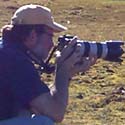 Spencer
Wynn Like paddling through deadheads in a flooded
marsh, our ship gingerly threads through the frozen, towering behemoths
from centuries past. Uuminaaq Sound slips silently by as the icebergs
pepper the surface of the water. This iceberg, like its shape must have
a storied past that we can only imagine as it shrinks away behind us. Spencer
Wynn Like paddling through deadheads in a flooded
marsh, our ship gingerly threads through the frozen, towering behemoths
from centuries past. Uuminaaq Sound slips silently by as the icebergs
pepper the surface of the water. This iceberg, like its shape must have
a storied past that we can only imagine as it shrinks away behind us. |
| Website by Jurpik Design. All contents copyright. |
